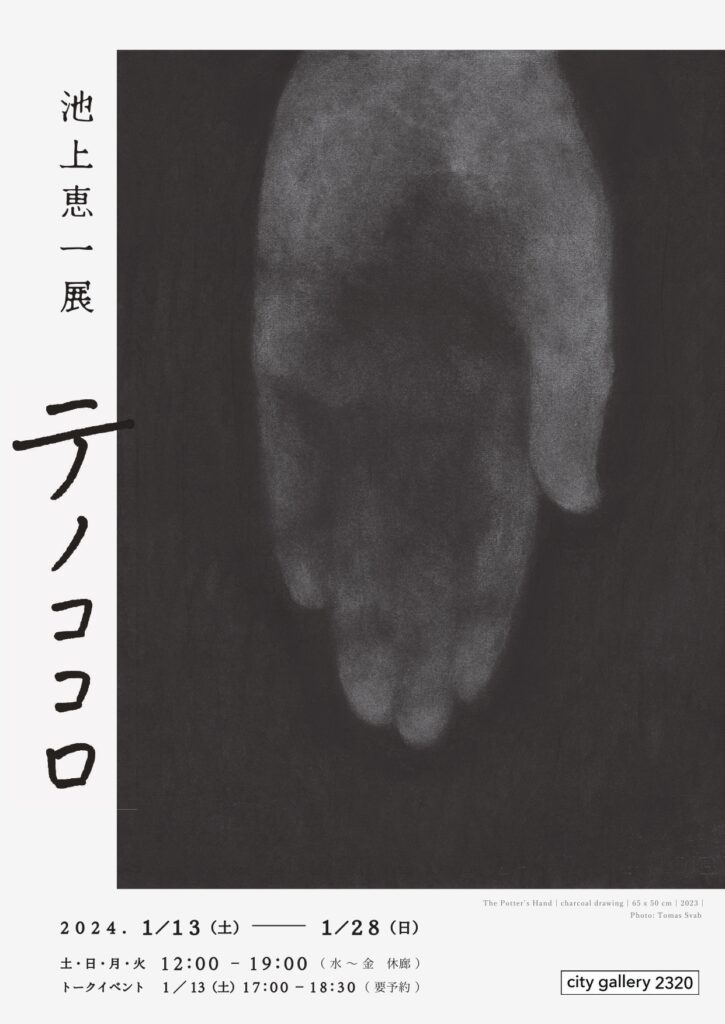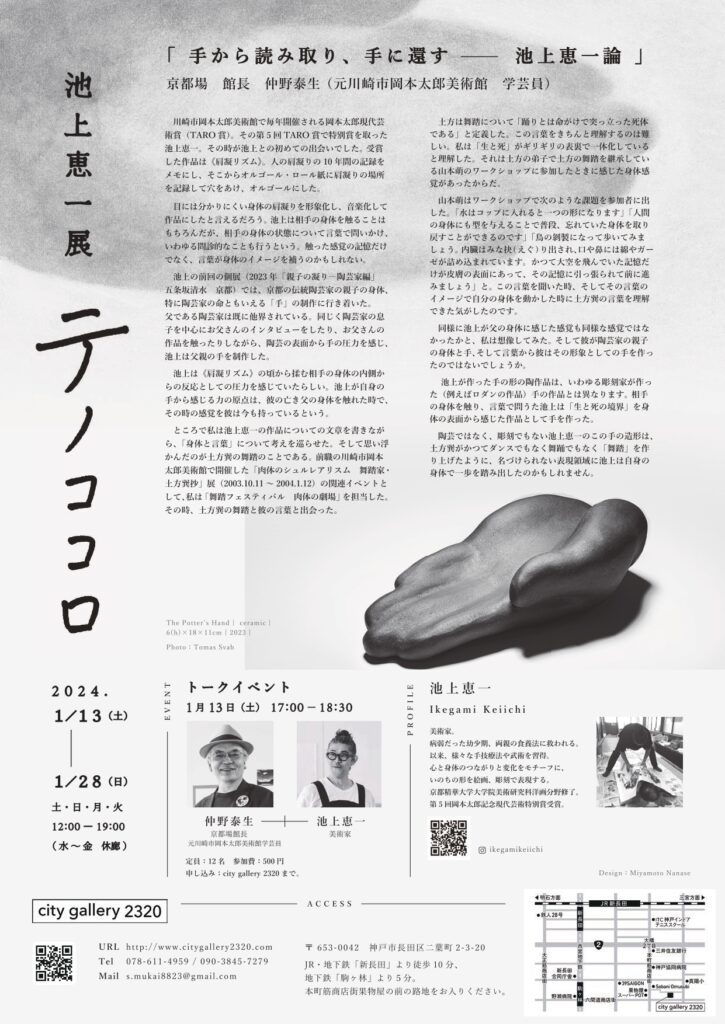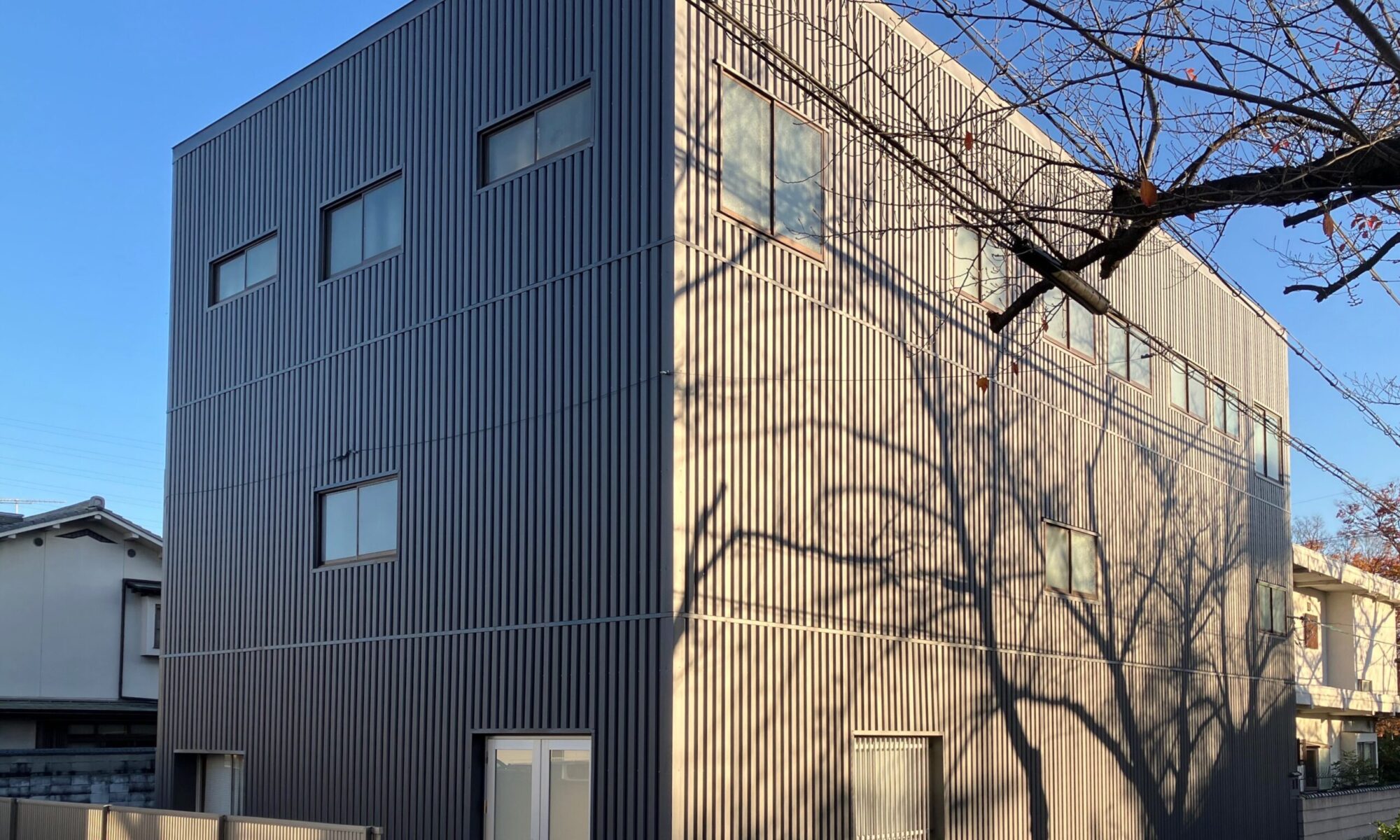

ASK + POST 所属作家の池上恵一が city gallery 2320 (神戸) にて個展「テノココロ 」を開催いたします。
池上 恵一展 - テノココロ –
会 場:city gallery 2320
会 期:2024年 1月13日(土)-28日(日)
時 間:12:00 – 19:00
OPEN : 土.日.月.火
休廊日:水.木.金
場 所:〒653-0042 神戸市長田区二葉町2-3-20
アクセス:JR・地下鉄「新長田」より徒歩10分、地下鉄「駒ヶ林」より5分。
本町筋商店街内果物屋の前の路地をお入りください。
電 話: 078-611-4959 / 090-3845-7279
メール:s.mukai8823@gmail.com
W E B: http:/www.citygallery2320.com
主 催:city gallery 2320
フライヤー・パンフレット Photo: Tomas Svab
Design: Miyamoto Nanase
English translation: Ikegami Kano
「手から読み取り、手に還す―池上恵一論」
京都場 館長 仲野 泰生 (元川崎市岡本太郎美術館 学芸員)
川崎市岡本太郎美術館で毎年開催される岡本太郎現代芸術賞(TARO賞)。その第5回 岡本太郎記念現代芸術大賞*で特別賞を取った池上恵一。その時が池上との初めての出会いでした。 受賞した作品は《肩凝リズム》。人の肩凝りの10年間の記録をメモにし、そこからオルゴール・ロール紙に肩凝りの場所を記録して穴をあけ、オルゴールにした。
目には分かりにくい身体の肩凝りを形象化し、音楽化して作品にしたと言えるだろう。 池上は相手の身体を触ることはもちろんだが、相手の身体の状態について言葉で問いかけ、いわゆる問診的なことも行うという。触った感覚の記憶だけでなく、言葉が身体のイメージを補うのかもしれない。
池上の前回の個展(2023年「親子の凝り―陶芸家編」五条坂清水 京都)では、京都の伝統陶芸家の親子の身体、特に陶芸家の命ともいえる「手」の制作に行き着いた。 父である陶芸家は既に他界されている。同じく陶芸家の息子を中心にお父さんのインタビューをしたり、お父さんの作品を触ったりしながら、陶芸の表面から手の圧力を感じ、池上は父親の手を制作した。
池上は《肩凝リズム》の頃から揉む相手の身体の内側からの反応としての圧力を感じていたらしい。池上が自身の手から感じる力の原点は、彼の亡き父の身体を触れた時で、その時の感覚を彼は今も持っているという。
ところで私は池上恵一の作品についての文章を書きながら、「身体と言葉」について考えを巡らせた。そして思い浮かんだのが土方巽の舞踏のことである。 前職の川崎市岡本太郎美術館で開催した「肉体のシュルレアリスム 舞踏家・土方巽抄」展(2003年10月11日~2004年1月12日)の関連イベントとして、私は「舞踏フェスティバル 肉体の劇場」を担当した。その時、土方巽の舞踏と彼の言葉と出会った。
土方は舞踏について 「踊りとは命がけで突っ立った死体である」と定義した。この言葉をきちんと理解するのは難しい。私は「生と死」がギリギリの表裏で一体化していると理解した。それは土方の弟子で土方の舞踏を継承している山本萌のワークショップの参加したときに感じた身体感覚があったからだ。
山本萌はワークショップで次のような課題を参加者に出した。山本は次のように語ります。 「水はコップに入れると一つの形になります」「人間の身体にも型を与えることで普段、忘れていた身体を取り戻すことができるのです」「鳥の剝製になって歩いてみましょう。内臓はみな抉り出され、口や鼻には綿やガーゼが詰め込まれています。かつて大空を飛んでいた記憶だけが皮膚の表面にあってその記憶に引っ張られて前に進みましょう」と。 この言葉を聞いた時、そしてその言葉のイメージで自分の身体を動かした時に土方巽の言葉を理解できた気がしたのです。
同様に池上が父の身体に感じた感覚も同様な感覚ではなかったかと、私は想像してみた。 そして彼が陶芸家の親子の身体と手、そして言葉から彼はその形象としての手を作ったのではないでしょうか。
池上が作った手の形の陶作品は、いわゆる彫刻家が作った(例えばロダンの作品)手の作品とは異なります。 相手の身体を触り、言葉で問うた池上は「生と死の境界」を身体の表面から感じた作品として手を作った。
陶芸ではなく、彫刻でもない池上恵一のこの手の造形は、土方巽がかつてダンスでもなく舞踊でもなく「舞踏」を作り上げたように、名づけられられない表現領域に池上は自身の身体で一歩を踏み出したのかもしれません。
池上恵一 プロフィール
美術家。病弱だった幼少期、両親の食養法に救われる。以来、様々な手技療法や武術を習得。心と身体のつながりと変化をモチーフに、いのちの形を絵画や彫刻で表現する。 京都精華大学大学院美術研究科洋画分野修了。第5回岡本太郎記念現代芸術特別賞受賞。
“Keiichi Ikegami, Reading from the Hand and Returning to the Hand” Yasuo NAKANO, Director, Kyoto-ba Former curator of the Taro Okamoto Museum of Art, Kawasaki
The Taro Okamoto Award for Contemporary Art, the TARO Memorial Award, is held annually at the Taro Okamoto Museum of Art in Kawasaki. Keiichi Ikegami won a special prize at the 5th TARO Memorial Award in 2002. That was my first encounter with Ikegami. His award-winning artwork was titled, “The Stiffness Rhythm,” in which Ikegami spent a decade recording the locations of stiff parts of the body onto rolls of music box paper, punched holes in those areas, and fed the paper through a music box to create a unique musical composition.
It can be said that Ikegami has made a work of art that visually captures the musical essence of stiffness in the body, a concept once imperceptible to the naked eye. Ikegami not only touches the body of the person he is working with; he also asks questions about their physical condition in what he calls a “medical interview.” In addition to the memory of the sensation of touch, these words help to supplement perceptions of the body.
In Ikegami’s most recent solo exhibition “Stiffness of Parent and Child: Ceramic Artists,” (Gojozaka Shimizu, Kyoto, 2023), he made ceramic pieces of the body of a father and son of traditional ceramic artists in Kyoto, paying particular attention to their “hands,” which are often considered the lifeforce of ceramic artists. The father, a potter, passed away some time ago. While interviewing the son, who is also a potter, Ikegami touched on some of the late father’s artworks. While doing so, he felt the pressure of the father’s hands from the surface of the ceramics, subsequently allowing Ikegami to create a representation of the late father’s hands.
Ever since “The Stiffness Rhythm,” Ikegami has touched people, felt their physical reactions and pressures, and has shaped their impressions into artwork. The origin of the power Ikegami feels from his hands began when he touched his own late father’s body— a sensation he still recalls to this day.
Incidentally, while writing about Keiichi Ikegami’s work, I started thinking about the ’body,’ ‘language,’ and the butoh, one of the Japanese contemporary dance forms, of Tatsumi Hijikata. I was in charge of the “Butoh Festival: Theater of the Body,” event that occurred in conjunction with the “Surrealism of the Body: The abridgement of Butoh Artist Tatsumi Hijikata” exhibition (October 11, 2003 – January 12, 2004) held at the Taro Okamoto Museum of Art in Kawasaki, where I previously worked. It was at that time that I encountered butoh, Tatsumi Hijikata, and his definition of the butoh dance.
Hijikata said, “[Butoh] Dancing is a corpse that stands on the edge of life.” These words are difficult to understand. I took it to mean that ‘life’ and ‘death’ are united at the very edge. I came to this realization when I participated in a workshop by Hijikata’s student and inheritor of the butoh dance, Moe Yamamoto.
In the workshop, Yamamoto gave us a physical movement challenge, which he narrated as follows: Water takes on a form when you pour it into a cup. By giving the human body a form, we reclaim the body that we so often forget. Walk around as a taxidermied bird, whose internal organs have been gutted. Whose mouth and nose have been stuffed with cotton and gauze. Only the memory of having once flown in the sky resides on the surface of your skin. Let that memory pull you forward. When I heard this narration and moved my body to the image of those words, I finally understood what Tatsumi Hijikata meant when he defined Butoh as ‘a corpse that stands on the edge of life.’
I imagine that the sensations Ikegami felt in his father’s body were similar to the sensations I felt in that workshop. And from the body and words of the father and son, Ikegami was able to create the hands, not just as physical forms, but as figurative forms as well.
The ceramic hands that Ikegami makes are different from hands made by other sculptors, such as Rodin. Ikegami crafts his pieces by touching the person’s body and posing questions with words. His artwork captures the sensation of the “boundary between life and death” that he feels on the surface of the body.
This hand modelling by Keiichi Ikegami is neither ceramics nor sculpture. It is Ikegami taking a step forward, with his own body, into the realm of expression that cannot be defined, just as Tatsumi Hijikata created a “butoh” that is neither traditional performance art nor dance.
Keiichi Ikegami Profile
Artist. As a sickly child, he was saved by his parents’ dietary regimen. Since then, he has learned various manual therapies and martial arts. He expresses the form of life in his paintings and sculptures, using connection and transformation of mind and body as motifs. Ikegami studied Western painting at Kyoto Seika University Graduate School of Fine Arts. He is the recipient of the 5th Taro Okamoto Memorial Special Prize for Contemporary Art.



